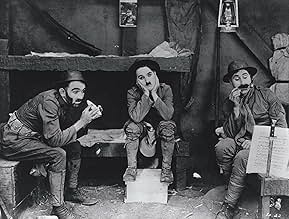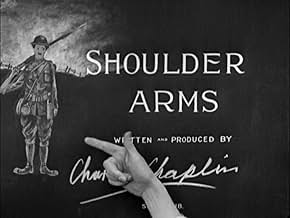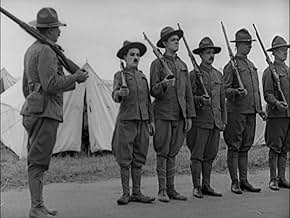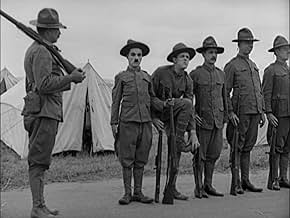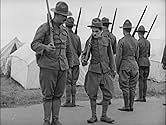IMDb RATING
7.3/10
7.8K
YOUR RATING
Charlie is a boot camp private who has a dream of being a hero who goes on a daring mission behind enemy lines.Charlie is a boot camp private who has a dream of being a hero who goes on a daring mission behind enemy lines.Charlie is a boot camp private who has a dream of being a hero who goes on a daring mission behind enemy lines.
Charles Chaplin
- Doughboy
- (as Charlie Chaplin)
Syd Chaplin
- Charlie's Comrade
- (as Sydney Chaplin)
- …
W.J. Allen
- Motorcyclist
- (uncredited)
L.A. Blaisdell
- Motorcyclist
- (uncredited)
Alva D. Blake
- U.S. Soldier
- (uncredited)
- …
Cliff Brouwer
- Soldier
- (uncredited)
E. Brucker
- Bit Part in Street Scene
- (uncredited)
F.S. Colby
- Soldier
- (uncredited)
Wellington Cross
- Motorcyclist
- (uncredited)
E.H. Devere
- Bit Part in Street Scene
- (uncredited)
C.L. Dice
- Motorcyclist
- (uncredited)
- Director
- Writer
- All cast & crew
- Production, box office & more at IMDbPro
Featured reviews
It's a comedy about the trench warfare just as WWI is about to come to an end. Charlie Chaplin is a doughboy in boot camp. In a series of scenes, he defeats many Germans. Then he wakes up.
It's a pretty long film at 45 minutes. There are some pretty funny scenes. The limburger cheese gag is somewhat weak. Capturing the 13 Germans could have used more slapstick. I do love the part where he's in enemy territories disguised as a tree. The Germans try to chop him down for firewood. That is by far my favorite part. The movie's success probably had a lot to do with the timing and the subject. However I can see the immense risk Chaplin was taking by making a comedy about trench warfare.
It's a pretty long film at 45 minutes. There are some pretty funny scenes. The limburger cheese gag is somewhat weak. Capturing the 13 Germans could have used more slapstick. I do love the part where he's in enemy territories disguised as a tree. The Germans try to chop him down for firewood. That is by far my favorite part. The movie's success probably had a lot to do with the timing and the subject. However I can see the immense risk Chaplin was taking by making a comedy about trench warfare.
Charlie Chaplin's Little Tramp or Little Man character wins World War I, called The Great War at the time, single handedly, even capturing the Kaiser, something the entire Allied armed forces were unable to do. Too bad it all turns out to be a dream, which is somewhat of a cop out and the weakest part of this mesmerizing silent short (almost a feature film at 46 minutes).
There are inventive gags galore including Charlie having to put on a gas mask to eat Limburger cheese sent from home, then using the cheese as a weapon against the Germans; Charlie sleeping underwater in a flooded trench next to a soldier he continues to annoy; Charlie disguising himself as a tree--one of his best sketches ever--and Charlie pretending to beat up his friend who has become a POW, then hugging him when the enemy is out of sight.
One amazing feature is how much Charlie, when he is behind enemy lines dressed as a German, resembles Hitler over ten years before Hitler and his Nazi thugs rose to dominate German politics. Obviously Hitler patterned his appearance after Charlie's from this film.
There are inventive gags galore including Charlie having to put on a gas mask to eat Limburger cheese sent from home, then using the cheese as a weapon against the Germans; Charlie sleeping underwater in a flooded trench next to a soldier he continues to annoy; Charlie disguising himself as a tree--one of his best sketches ever--and Charlie pretending to beat up his friend who has become a POW, then hugging him when the enemy is out of sight.
One amazing feature is how much Charlie, when he is behind enemy lines dressed as a German, resembles Hitler over ten years before Hitler and his Nazi thugs rose to dominate German politics. Obviously Hitler patterned his appearance after Charlie's from this film.
One of Charlie Chaplin's very best shorter features, "Shoulder Arms" is a wonderful combination of comedy, commentary, and adventure. Charlie plays a soldier who heads off to World War I, and in the course of 40 minutes or so, it provides a light-hearted but in many respects believable portrayal of what life was like in the trenches. The story also combines some fine slapstick with some exciting adventures.
In this movie, Chaplin hits the perfect balance between humor and substance, helping us to sympathize with those who bore the burdens of the war, without ever becoming sentimental. The other characters are nicely conceived and acted, with the engaging Edna Purviance, the versatile Syd Chaplin, and other talented supporting players pitching in.
The story has many creative turns, plus a couple of good surprises. It's great entertainment, and thoughtful as well. Make sure to take a look if you enjoy Chaplin or silent comedies in general.
In this movie, Chaplin hits the perfect balance between humor and substance, helping us to sympathize with those who bore the burdens of the war, without ever becoming sentimental. The other characters are nicely conceived and acted, with the engaging Edna Purviance, the versatile Syd Chaplin, and other talented supporting players pitching in.
The story has many creative turns, plus a couple of good surprises. It's great entertainment, and thoughtful as well. Make sure to take a look if you enjoy Chaplin or silent comedies in general.
Chaplin took so long to direct this 3 reel comedy, his longest to that old date. Once in France and dealing with with Chaplin as a Boot Hill soldier who still looks like an awkward tramp . At the military quarter he doesn't obtain letter from home, at last, he achieves a pack containing limburger cheese. After that, he has the cheese from a mousetrap. Later on, he volunteers to wander behind German lines and posing as a tree takes 13 prisoners , surrendering them from the enemy trench . Finally, with the help a beautiful French girl, Edna Purviance, captures the Kaiser, Syd Chaplin, and the Crown Prince.
The picture had success at boxoffice and the public liked it, specially the following scenes : when Charlie under a gas mask eats the cheese and subsequently he throws it over the enemy lines, as Charlie disguises as a tree trunk and kicks German soldiers in the seat of their pants , and when he takes the Kaiser and is given a statue of victory . In the picture appears two Chaplin's regular : Edna Purviance and Syd Chaplin in a double role as The Kaiser and Charlie's comrade.
This was the longest film to that date and it premiered only 3 weeks before the end of the WWII. This was a 3 reel comedy, he previously directed 1 or 2 reel short movies, such as : Our hero, Night at the show, The fireman, The adventurer, The count, The floorwalker, The circus, The cure, The inmigrant, Burlesque on Carmen, 3 Charlies and one phoney, among others. Shortly after, he directed long time films as The gold rush, the Kid, City lights, Modern times, The great dictator, Monsieur Verdoux, Limelight, A King in NY, and his last one : A countess from Hong Kong. Rating 7.5/10. Better than average Chalie movie. Essential and indispensable watching for Charles Chaplin fans. Well worth seeing
The picture had success at boxoffice and the public liked it, specially the following scenes : when Charlie under a gas mask eats the cheese and subsequently he throws it over the enemy lines, as Charlie disguises as a tree trunk and kicks German soldiers in the seat of their pants , and when he takes the Kaiser and is given a statue of victory . In the picture appears two Chaplin's regular : Edna Purviance and Syd Chaplin in a double role as The Kaiser and Charlie's comrade.
This was the longest film to that date and it premiered only 3 weeks before the end of the WWII. This was a 3 reel comedy, he previously directed 1 or 2 reel short movies, such as : Our hero, Night at the show, The fireman, The adventurer, The count, The floorwalker, The circus, The cure, The inmigrant, Burlesque on Carmen, 3 Charlies and one phoney, among others. Shortly after, he directed long time films as The gold rush, the Kid, City lights, Modern times, The great dictator, Monsieur Verdoux, Limelight, A King in NY, and his last one : A countess from Hong Kong. Rating 7.5/10. Better than average Chalie movie. Essential and indispensable watching for Charles Chaplin fans. Well worth seeing
One of the prices of superstardom is that you have to become adaptable. When the US joined the World War in 1917 Charlie Chaplin was at the height of his popularity. Naturally, he was expected to make some sort of contribution. Chaplin had already set his short films in all sorts of locations, even at different time periods, and had given his little tramp all manner of occupations, so soldiering in the trenches shouldn't have been too big a step. However, Shoulder Arms is, if not a propaganda piece (it was released a bit late for that), at least one that had to have a certain outlook. As a result Chaplin was constrained somewhat, and it shows.
The first half of the picture, which is set during Charlie's training and among his comrades in the trench seems a little muted compared to other Chaplin pictures of this period. The reason for this is clear – it wouldn't have had the right effect if there were seen to be too much antagonism between soldiers. Characters like the burly drill sergeant or Charlie's buddy (played his brother Syd) would make ideal bugbears in any other picture, but here all we get is a bit of appropriately brotherly tussling between Charlie and Syd. When you see how weak these opening ten minutes are you realise how much of Chaplin's comedy depended upon playing off others and pricking pomposity.
Fortunately, Chaplin gets to make up for all this when his little tramp goes out to face the German foe. Here he can go all out with making his enemies look ridiculous, getting the most out of his varyingly-sized supporting players. We have Henry Bergman as a roly-poly German, Albert Austin as a gangly one, and best of all Loyal Underwood as a short but self-important German officer. This is Underwood's finest moment, and he really puts a lot of energy and spirit into the part. And Chaplin gets to set up some great routines, with some ingenious ways of defeating foes, not to mention one of his best ever entrances when he appears out of the landscape in his tree disguise.
And Chaplin was clearly savvy enough to realise that the beginning of the picture contained some fairly poor material. Consequently he edits in a handful of shots of antics in the German trench (with Underwood at his most animated), which serve as nothing more than a little touch of uproar, and a promise of things to come.
And now we must have that all-important statistic – Number of kicks up the arse: 7 (1 for, 0 against, 6 other)
The first half of the picture, which is set during Charlie's training and among his comrades in the trench seems a little muted compared to other Chaplin pictures of this period. The reason for this is clear – it wouldn't have had the right effect if there were seen to be too much antagonism between soldiers. Characters like the burly drill sergeant or Charlie's buddy (played his brother Syd) would make ideal bugbears in any other picture, but here all we get is a bit of appropriately brotherly tussling between Charlie and Syd. When you see how weak these opening ten minutes are you realise how much of Chaplin's comedy depended upon playing off others and pricking pomposity.
Fortunately, Chaplin gets to make up for all this when his little tramp goes out to face the German foe. Here he can go all out with making his enemies look ridiculous, getting the most out of his varyingly-sized supporting players. We have Henry Bergman as a roly-poly German, Albert Austin as a gangly one, and best of all Loyal Underwood as a short but self-important German officer. This is Underwood's finest moment, and he really puts a lot of energy and spirit into the part. And Chaplin gets to set up some great routines, with some ingenious ways of defeating foes, not to mention one of his best ever entrances when he appears out of the landscape in his tree disguise.
And Chaplin was clearly savvy enough to realise that the beginning of the picture contained some fairly poor material. Consequently he edits in a handful of shots of antics in the German trench (with Underwood at his most animated), which serve as nothing more than a little touch of uproar, and a promise of things to come.
And now we must have that all-important statistic – Number of kicks up the arse: 7 (1 for, 0 against, 6 other)
Did you know
- TriviaMany in Hollywood were nervous that one of their most famous peers was going to tackle the subject of WWI. It was released shortly before the Armistice, so it did not help boost national morale, but it did end up as one of Charles Chaplin's most popular films, and it was particularly popular with returning doughboys.
- GoofsIn the woods, where The Doughboy runs to hide from the pursuing Germans, automobiles are visible traveling on a highway on the horizon.
- Crazy creditsThe short opens with a title card showing a caricature of Chaplin dressed as a World War I soldier, and text reading "Shoulder Arms Written and Produced by" followed by a blank space. A live action hand appears and points to the title, then the drawing, then uses a piece of white chalk to sign "Charles Chaplin" in the blank space, then points to the caricature one more time.
- ConnectionsEdited into The Chaplin Revue (1959)
Details
- Release date
- Country of origin
- Official sites
- Languages
- Also known as
- Camouflage
- Filming locations
- 7th Street and Broadway, Downtown, Los Angeles, California, USA(traffic cop trouble in front of Bullock's Department Store.)
- Production company
- See more company credits at IMDbPro
- Runtime36 minutes
- Color
- Sound mix
- Aspect ratio
- 1.33 : 1
Contribute to this page
Suggest an edit or add missing content


